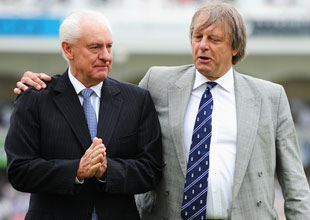Our vision for a better game
Giles Clarke

|
|||
|
Related Links
|
|||
A huge white elephant sits in the Dubai desert, otherwise known as the purpose-built offices of the ICC. The most bizarre part of this monument to profligacy can be found in the chief executive's office: a private lavatory unavailable to the general staff, but insisted on, at considerable cost, at the time of design.
Combine this with huge travel bills, expensive hotel suites, even golf club memberships that, in the case of one chief executive, amounted to $US57,000 per annum - the equivalent of the annual distribution to six Affiliate Members - and the impression is of a business without adequate controls, run for the management, not for the shareholders. The ICC are a members-owned cooperative, so what exactly have the members been doing?
When Alan Isaac became ICC president in June 2012, he asked me to take over the chairmanship of the finance and commercial affairs committee of IDI, the ICC's commercial arm. I was already chairman of the commercial rights 2015-23 working group, which had produced a first plan in October 2011, drawn up by Campbell Jamieson, the ICC general manager (commercial).
The commercial rights revenues pay all the ICC bills, and provide the key funds for all the Associates and Affiliates, and for important distributions to the ten Full Members. The rights were sold for $500m for 2000-07, and $1.5bn for 2007-15.
Of this vast sum, the ten Full Members each received $52.5m over the eight years - an average of $6.5m per year. From 2007-15 ICC events were budgeted to cost $512m to stage, while ICC administrative costs, squirrelled away in all kinds of accounting places, were $252m. The 96 Associates and Affiliates received $125m in total, from a pool of $314m, which included a $45m payment to the Asian Cricket Council. The remaining amount was swallowed up by their own event costs ($67m), ICC regional expenditure ($40m), subscriptions paid back to ICC ($41m), the High Performance Programme ($8.5m), and other ICC costs.
So much for the numbers. But a disproportionate amount of money was being spent - wasted, some might argue - on costs, rather than being used to develop and promote cricket in the membership.
For the ICC to agree to a media rights contract, all the Full Members must sign a Member Participation Agreement, which sets out the terms under which their teams are available for ICC events. Draft MPAs were sent to all countries in 2012, and it became apparent the BCCI were unhappy.
They believed, correctly, that Indian TV rights had contributed significantly to the two previous ICC deals, and that they were not being adequately compensated for "hiring out their team to the ICC", in the words of Cricket Australia. The BCCI made it clear that, if their concerns were not recognised, they would feel uncomfortable about continuing in the ICC.
For 15 years, India had been paid the same as the other Full Members from the ICC's central fund. Their concerns appeared legitimate. From a purely commercial perspective, it was essential that cricket's position in India remained pre-eminent. The 2011 World Cup, co-hosted by them, Bangladesh and Sri Lanka, was an enormous success. So there were strong reasons to listen to the BCCI, the ECB and CA.
The working group obtained vast amounts of information on Full Members' finances, which allowed them to get to grips with the costs of Test cricket, and identify loss-making tours. Finally, a full structural reform of the ICC, acceptable to the three boards, was agreed, along with a complex model that compensated Members for providing their teams for ICC events, the costs of which would now be driven down by a new panel of event experts.
A working draft was produced, intended as a basis for debate. Inevitably it was leaked, causing an absurd furore. The critics did not read it fully, did not ask questions of those involved, and did not realise it was aimed merely at kick-starting meaningful dialogue.
Following much discussion, with two meetings in Dubai and a third in Singapore, agreement was reached, and resolutions were passed on February 8, 2014. As so often in cricket administration, these were widely - perhaps deliberately - misinterpreted. We had to harden ourselves against uninformed and biased comment to deliver our vision for a better and more financially secure cricketing world.
The FTP has not been abolished, but left to individual boards to arrange among themselves. It has been extended to 2023, with the top eight nations playing each other. And India do not get a veto. In fact, they were outvoted during the process, but the key is all major members are actively involved in leadership. India are inside the house now.
The ECB have already reserved a date in the cycle from 2015-23 for a Lord's Test to the Associate who win the Intercontinental Cup and go on to defeat the No. 10 side in the Test rankings. A glittering prize!
Giles Clarke is chairman of the ECB

